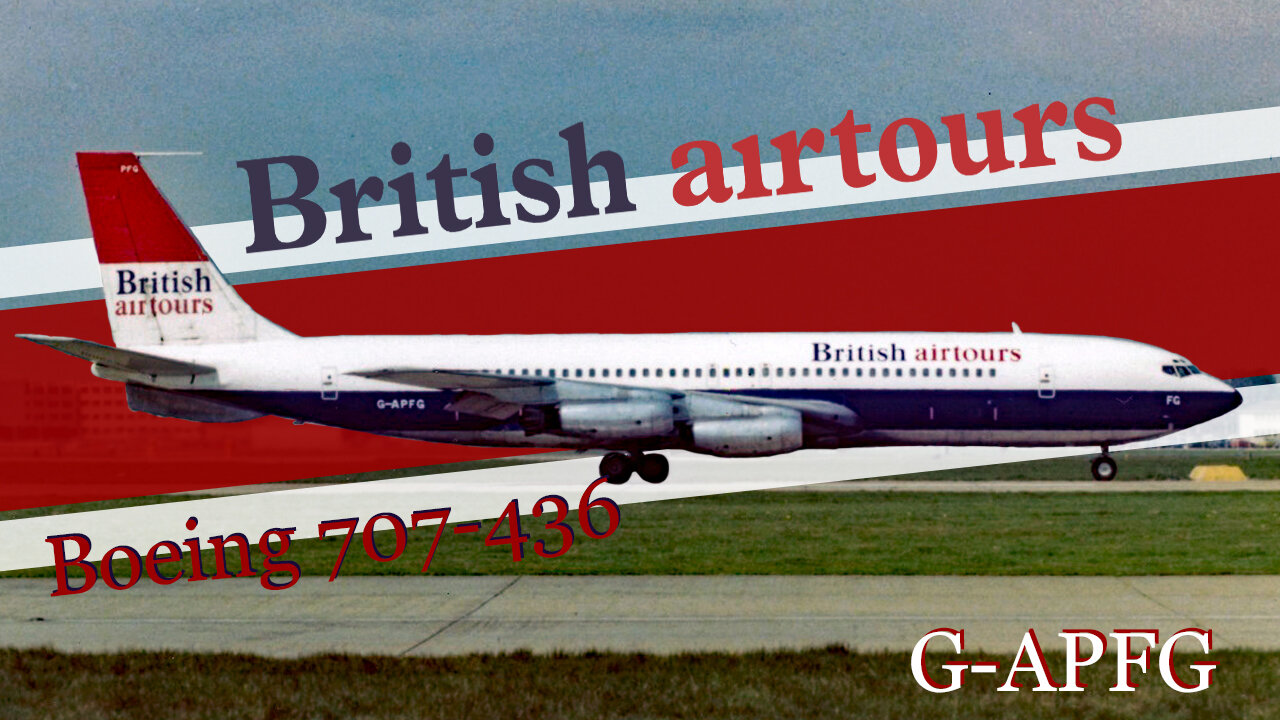Premium Only Content

The Legacy of British Airtours 707-436 (G-APFG): A Historic Journey
Welcome, aviation enthusiasts, to an exciting journey into the history and legacy of the iconic British Air Tours Boeing 707-436, registered as G-APFG. An airliner known for it’s long service to the British people during it’s lifetime and after it was retired. In this short video, we'll delve into the rich history of this aircraft, its significance in the aviation industry, and the lasting impact it left behind.
Our story begins in the early 1950’s, when the aviation world witnessed the birth of a true legend: the Boeing 707. Manufactured by the Boeing Corporation, this aircraft was designed to be a revolutionary passenger jet that promised innovation, that also excelled in cargo and military purposes. This particular aircraft had it’s first flight on May 9, 1960, with delivery to British Overseas Airways Corporation, otherwise known as BOAC a month later.
The Boeing 707 featured cutting-edge technologies such as using early automatic flight stabilization technology and a spacious interior layout, as compared to earlier Propeller based airliner designs, that could hold up to 189 Passengers in a one class layout, setting it apart from its competitors. Along with these capabilities, the Boeing 707 carried four Rolls Royce Conway turbofans that produced 17,500 lbf or 78 kN each, allowing this aircraft to cruise at up to 525 kn or 972 km/h. With a full fuel load on board the aircraft could fly over 3,700 nmi or 6,900 km
Our airplane had a fairly long tenure with BOAC, lasting thirteen years with it’s original operator. In the process that would eventually lead to the formation of British Airways in 1974, this aircraft was transferred to British European Airways Airtours company in early 1973. When the merger between BOAC and BEA was complete in 1974, the aircraft became part of British Air Tours, the Vacation charter airline subsidiary of the newly formed British Airways. In the span of two years the aircraft had gone from the classic BOAC dark blue cheatline livery, through the BEA livery with a part of the Union Jack on the tail, to the 1970’s era British Airways red tailed “Negus” livery.
As a member of the British Airtours company, this aircraft was used almost exclusively for transporting passengers to vacation spots around the globe for what were known as “Inclusive Tours” or “Package tours” which comprised of not only airfare, but hotel and ground transportation as well. This aircraft continued plying the skies for British Air Tours until it was retired from paying passenger service in 1981.
It was at this point that the aircraft was purchased by a company called Aviation Traders. They initially set up this aircraft at London’s Stansted airport as a training hull for maintenance and emergency crews. After several years of being used and abused by technicians and fire crews, the aircraft was broken up in 1991. The cockpit section was saved and restored, and is now on display at the South Wales Aviation Museum, St Athan Wales, United Kingdom. It is at this location that a previous aircraft covered by this channel is also partially on display, the AeroSpacelines Super Guppy registered as F-BTGV.
This plane embarked on several historic journeys, connecting distant lands and bringing people together in ways previously unimaginable.
From crossing the Atlantic to venturing across the Mediterranean , this aircraft symbolized the spirit of exploration and the thrill of adventure that air travel offered.
Although the era of the Boeing 707 and British Airtours has passed, their legacy lives on.
The innovations pioneered by the Boeing 707 and the services provided by British Airtours have left an indelible mark on the aviation industry, influencing modern aircraft designs and shaping the expectations of passengers worldwide.
As we conclude our journey through history, we remember this Boeing 707, with a sense of nostalgia and admiration.
This aircraft was more than just metal and engines; it was a vessel that carried dreams, aspirations, and stories of countless travelers.
Thank you for joining us on this captivating exploration of this British Airtours Boeing 707. As we celebrate the past, let us also look forward to the exciting advancements that lie ahead in the future of aviation.
Remember, the sky is just the beginning, not a limit
Until next time, stay curious and keep soaring!
-
 10:05
10:05
MattMorseTV
5 hours ago $2.11 earnedHe actually did it...
14K9 -
 LIVE
LIVE
Anthony Rogers
1 day agoEpisode 376 - Todd Schowalter
35 watching -
 LIVE
LIVE
megimu32
1 hour agoOTS: Movie Tie-In Games + Remakes: Let’s Play Memory Lane
64 watching -
 LIVE
LIVE
Adam Does Movies
9 hours agoTalking Movies + Ask Me Anything - LIVE
62 watching -
 1:17:18
1:17:18
Glenn Greenwald
1 day agoWhat are CBS News' Billionaire Heirs Doing with Bari Weiss? With Ryan Grim on the Funding Behind It; Europe Capitulates to Trump Again | SYSTEM UPDATE #494
83.3K31 -
 1:43:49
1:43:49
RiftTV
3 hours agoCNN Calls Black NY Shooter WHITE, Cincinnati FATIGUE | The Rift | Guest: Braeden Sorbo, 2Protects1
22.8K10 -
 4:21:04
4:21:04
LumpyPotatoX2
4 hours agoKilling Floor 3: Rampage & Chaos - #RumbleGaming
2.33K -
 LIVE
LIVE
BrancoFXDC
4 hours agoPlaying Ranked Warzone - Pursuit of Diamond Rank
59 watching -
 1:11:41
1:11:41
Omar Elattar
4 hours agoThe Brain Experts: "Your Overthinking Problem Has A Physical Solution & We Can Show You!"
6.92K1 -
 LIVE
LIVE
Mattnifico
3 hours agoREPLAYING EVERY FORZA HORIZON GAME - Forza Horizon 1 (Part 2)
19 watching